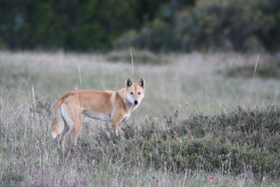The Dingo is estimated to have arrived in Australia 5000 to 8000 years ago and is considered the native apex predator in most mainland terrestrial ecosystems. Dingoes and dingoes that have a percentage of domestic dog genes are indistinguishable in appearance and behaviour, they are collectively referred to as 'Wild dogs' within national management frameworks.
Wild dogs perform the function of a top order predator in Australian ecosystems by preying on native and introduced herbivores. The behaviour of hybridised and non-hybridised wild dogs and dingos has been shown to be the same in this role.

DNA evidence suggests that ACT wild dog populations can best be described as dingoes with a small proportion of domesticated dog genes. DNA results suggest that populations of wild dogs in Namadgi National Park contain 75% to 85% Dingo ancestry, this is considered a high value in South-Eastern Australia.
In land adjoining to rural properties, wild dogs are managed due to their impact on livestock and the economic and wellbeing impacts on graziers. Within areas of Namadgi National Park no control occurs and through this management wild dogs are protected as top order predators.
Cultural significance
Dingoes are known to the Ngunnawal peoples as Miri.
Miri hold a special place within the Ngunnawal society and dreaming since the first sunrise, representing resilience and protection.
Miri within the Ngunnawal family groups were raised in the company of Women and Children and provided an effective hunting aid, a living blanket and protection against invaders while men were away for hunting or ceremony. The migration and footprints of wild Miri were tracked to find waterholes and pathways (songlines) across Country to other food sources and neighbouring nation groups.
Management policy
Management of invasive pest animals is guided by the ACT Pest Animal Management Strategy and Namadgi National Park Plan of Management [4.3 MB]. Management is to address significant impacts on livestock, especially sheep, in adjoining rural properties.
In the ACT, wild dogs are listed as pest animals in the Pest Animals Declaration 2021, which falls within the Pest Plants and Animals Act 2005.
ACT is signatory to three cooperative Wild Dog Management plans with neighbouring stakeholders in NSW including NSW National Parks and Wildlife Service (NPWS), South East Local Land Service (LLS) and private landholders.
Management tools
Control methods utilised include leghold traps, poisoned baits (1080 sodium fluoroacetate baiting), shooting, exclusion fencing and guard animals. Use of methods vary in effectiveness and adoption across the landscape (NSW and ACT). Only through a combination of tools can effective landscape level management be achieved.
Control methods are best practice and chosen with consideration of animal welfare, effectiveness, user and public safety and situational suitability.
Monitoring and research
All aspects of wild dog management are monitored to ensure efficient delivery, cost effectiveness and ethical implementation.
The primary indicator of program success is the number of stock losses reported in relation to the number of sheep being grazed, which provides an assessment of the economic and social damage to rural landholders.
The ACT Government monitors wild dog abundance in core conservation areas of Namadgi National Park and in the buffer zone adjacent to rural properties to ensure that management programs do not compromise conservation goals.
The ACT Government is supporting ongoing PhD research into the ecological role of wild dogs within the ACT to better understand how they influence the natural ecosystem. This work will be used to inform management decisions in the future.
Advice for wild dog encounters

Incidents of wild dogs in Namadgi National Park interacting with people are rare. However, it is sensible to take precautions to discourage these animals from gradually becoming less fearful of humans.
If you encounter a wild dog in Namadgi National Park, follow the recommendations outlined below:
- Do not approach the animal. You can use binoculars or your camera zoom if you would like to watch from a distance.
- Never feed wild dogs, even indirectly. Lock up your food stores, packs and eskies, and take all of your food scraps and rubbish with you.
- If a wild dog approaches you: face the animal, fold your arms, keep eye contact and calmly back away. Do not run or wave your arms.
- In the unlikely event of threatening behaviour, strike the animal with a stick or backpack. Once you are a safe distance away, report the incident to Access Canberra or the Namadgi Visitor Centre.
More information
- Wild dogs in the Australian Alps - Australian Alps National Parks
Please report any incidents concerning wild dogs to the Namadgi Visitor Centre on 02 6207 2900 or Access Canberra on 13 22 81.
